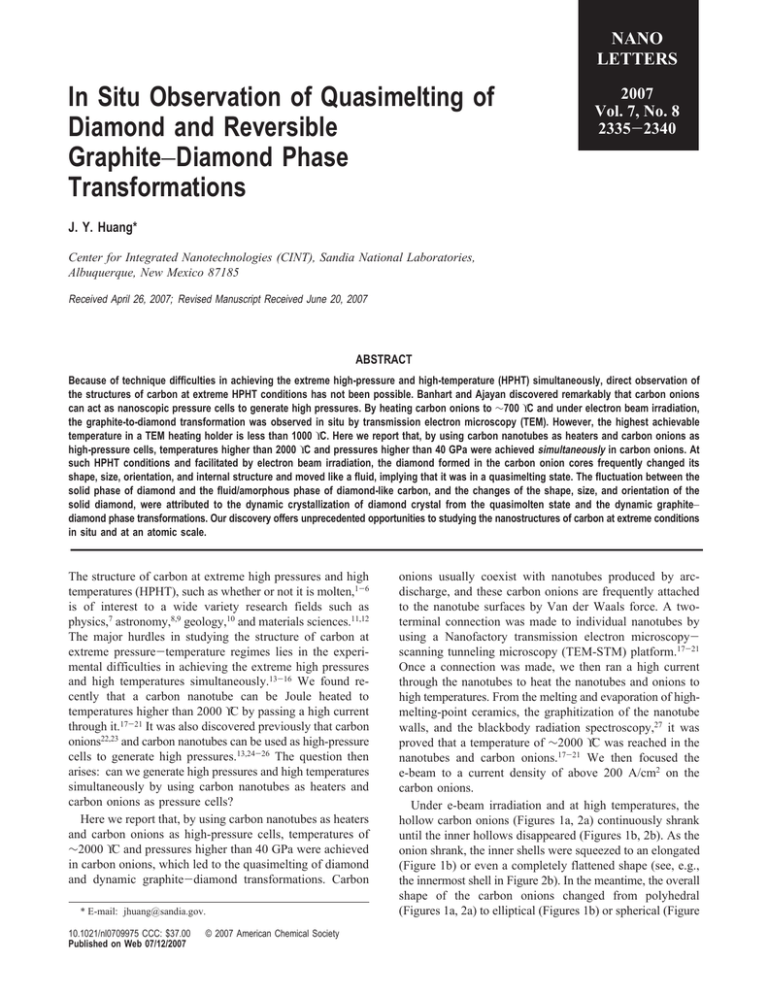In Situ Observation of Quasimelting of Diamond and Reversible Graphite Diamond Phase
advertisement

NANO
LETTERS
In Situ Observation of Quasimelting of
Diamond and Reversible
Graphite−Diamond Phase
Transformations
2007
Vol. 7, No. 8
2335-2340
J. Y. Huang*
Center for Integrated Nanotechnologies (CINT), Sandia National Laboratories,
Albuquerque, New Mexico 87185
Received April 26, 2007; Revised Manuscript Received June 20, 2007
ABSTRACT
Because of technique difficulties in achieving the extreme high-pressure and high-temperature (HPHT) simultaneously, direct observation of
the structures of carbon at extreme HPHT conditions has not been possible. Banhart and Ajayan discovered remarkably that carbon onions
can act as nanoscopic pressure cells to generate high pressures. By heating carbon onions to ∼700 °C and under electron beam irradiation,
the graphite-to-diamond transformation was observed in situ by transmission electron microscopy (TEM). However, the highest achievable
temperature in a TEM heating holder is less than 1000 °C. Here we report that, by using carbon nanotubes as heaters and carbon onions as
high-pressure cells, temperatures higher than 2000 °C and pressures higher than 40 GPa were achieved simultaneously in carbon onions. At
such HPHT conditions and facilitated by electron beam irradiation, the diamond formed in the carbon onion cores frequently changed its
shape, size, orientation, and internal structure and moved like a fluid, implying that it was in a quasimelting state. The fluctuation between the
solid phase of diamond and the fluid/amorphous phase of diamond-like carbon, and the changes of the shape, size, and orientation of the
solid diamond, were attributed to the dynamic crystallization of diamond crystal from the quasimolten state and the dynamic graphite−
diamond phase transformations. Our discovery offers unprecedented opportunities to studying the nanostructures of carbon at extreme conditions
in situ and at an atomic scale.
The structure of carbon at extreme high pressures and high
temperatures (HPHT), such as whether or not it is molten,1-6
is of interest to a wide variety research fields such as
physics,7 astronomy,8,9 geology,10 and materials sciences.11,12
The major hurdles in studying the structure of carbon at
extreme pressure-temperature regimes lies in the experimental difficulties in achieving the extreme high pressures
and high temperatures simultaneously.13-16 We found recently that a carbon nanotube can be Joule heated to
temperatures higher than 2000 °C by passing a high current
through it.17-21 It was also discovered previously that carbon
onions22,23 and carbon nanotubes can be used as high-pressure
cells to generate high pressures.13,24-26 The question then
arises: can we generate high pressures and high temperatures
simultaneously by using carbon nanotubes as heaters and
carbon onions as pressure cells?
Here we report that, by using carbon nanotubes as heaters
and carbon onions as high-pressure cells, temperatures of
∼2000 °C and pressures higher than 40 GPa were achieved
in carbon onions, which led to the quasimelting of diamond
and dynamic graphite-diamond transformations. Carbon
* E-mail: jhuang@sandia.gov.
10.1021/nl0709975 CCC: $37.00
Published on Web 07/12/2007
© 2007 American Chemical Society
onions usually coexist with nanotubes produced by arcdischarge, and these carbon onions are frequently attached
to the nanotube surfaces by Van der Waals force. A twoterminal connection was made to individual nanotubes by
using a Nanofactory transmission electron microscopyscanning tunneling microscopy (TEM-STM) platform.17-21
Once a connection was made, we then ran a high current
through the nanotubes to heat the nanotubes and onions to
high temperatures. From the melting and evaporation of highmelting-point ceramics, the graphitization of the nanotube
walls, and the blackbody radiation spectroscopy,27 it was
proved that a temperature of ∼2000 °C was reached in the
nanotubes and carbon onions.17-21 We then focused the
e-beam to a current density of above 200 A/cm2 on the
carbon onions.
Under e-beam irradiation and at high temperatures, the
hollow carbon onions (Figures 1a, 2a) continuously shrank
until the inner hollows disappeared (Figures 1b, 2b). As the
onion shrank, the inner shells were squeezed to an elongated
(Figure 1b) or even a completely flattened shape (see, e.g.,
the innermost shell in Figure 2b). In the meantime, the overall
shape of the carbon onions changed from polyhedral
(Figures 1a, 2a) to elliptical (Figures 1b) or spherical (Figure
Figure 1. Sequential HRTEM images showing the shrinkage of a carbon onion and the formation of a diamond in the core at high temperatures
and under e-beam irradiation. The onion was attached to a carbon nanotube (The nanotube was not shown in (a,b), but it can be seen in
(c-e)). The voltage applied to the nanotube was 2.5 V. The dark contrast in the core of (c-e) corresponds to diamond. The time intervals
in (a-e) are 0, 2, 10, 15, and 14 min, respectively. The diameters of the carbon onions shown in (c-e) are 18.2, 17.4, and 16.4 nm,
respectively. The blue circles having the same diameters are used as references to indicating the diameter reduction of the carbon onion.
Inset in (c) is an FFT of the framed region in the same figure. A 5-fold twin is marked in (e). The diamond lattice planes are indicated.
2b). As the onions shrank, the number of shells was
increased, e.g., from 33 (Figure 1a) or 23 (Figure 2a) to 38
(Figure 1b) or 31 (Figure 2b), respectively. The increase of
the number of shells was duo to the growth of new shells
from the inner shells but not from the outer surface. The
radiation process induced knock-on displacements, collision
cascades, and flux of carbon atoms toward the core, resulting
in an increase of carbon atoms in the inner shells. At high
2336
temperatures, the atoms in the inner shells rearranged to form
new shells. On the contrary, the outer shells were usually
peeled off due to the sublimation of carbon atoms, a process
similar to the peeling off of walls from a multiwalled carbon
nanotube (MWCNT).18,28-30 With shrinking of the onion, the
lattice spacing between the shells was reduced continuously
from 0.34 to 0.27 nm. The smallest spacing was measured
to be 0.27 nm before a diamond was nucleated. According
Nano Lett., Vol. 7, No. 8, 2007
Figure 2. Sequential HRTEM images showing the shrinkage of a carbon onion and the formation of a diamond in the core at high temperatures
and under e-beam irradiation. The onion was attached to the surface of a carbon nanotube. The voltage applied to the nanotube was 2.5 V.
The time intervals in (a-e) are 0, 15, 10, 3, and 2 min, respectively. Note that the number of shells was increased from 23 (a) to 31 (b),
and the innermost shell was flattened (b) as the onion shrank. As part of the onion shells were cut (c), the onion slipped out (d) and then
the diamond core was converted back to carbon onion shells (e). The horizontal and vertical arrows point out the same onions, respectively.
The arrowhead points out the diamond lattice fringes. The diamond lattice planes are indicated.
to the lattice spacing versus pressure plot, a pressure much
higher than 40 GPa is required to compress the c-axis spacing
of graphite to 0.27 nm.31
Once the diamond was nucleated, it frequently changed
its shape, size, and orientation (Figures 1c-e, 3; Movies M1,
M2, Supporting Information). The diamond usually exhibited
a dark contrast and moved like a fluid; occasionally, lattice
fringes or lattice images were captured in the video recording,
which showed the formation of single crystals (Figures 2c,
3c, 3e) or twinned crystals (Figures 1c,d, 3b) or 5-foldtwinned crystals (Figure 1e) at different times. From the twodimensional lattice images (Figures 1c-e, 3b, 3d), the two
sets of {111} planes were clearly identified, and the lattice
spacing was measured to be 0.2 nm and the angle between
the two sets of {111} planes was measured to be 70.5°, which
match excellently with that of the diamond. Fast Fourier
transformation (FFT) of the two-dimensional lattice images
(e.g., framed area in Figure 1c) indicated that the electron
diffraction pattern (inset in Figure 1c) is consistent with that
of diamond. We have also conducted energy dispersive X-ray
spectroscopy analysis, and carbon was the only element
presented in the onion. These analyses confirmed conclusively that the condensed phase formed in the onion core
was diamond.
Nano Lett., Vol. 7, No. 8, 2007
As the number of the shells in the onion was decreased
due to the sublimation of carbon atoms from the onion
surfaces, the pressure in the onion was reduced but the
temperatures remained at ∼2000 °C. At high temperatures
and ambient pressure, the diamond crystals were converted
back to carbon onions (Figures 2d,e, 3e,f, Movie M2). We
attempted to cut off part of the shells in the onion
(Figure 2c) to see whether or not we could release the
diamond core, but the onion slipped out (Figure 2d) before
we could complete the cutting.
The quasimelting of diamond is well demonstrated in
Figure 3 (Movie M2). The diamond crystal with a diameter
of about 5 nm moved rapidly like a fluid, and occasionally
lattice fringes or lattice images were detected. The diamond
changed from a polycrystal (Figure 3a) to a multiple-twinned
crystal (Figure 3b) to a single crystal (Figure 3c) to a twinned
crystal again (Figure 3d) to a small single crystal
(Figure 3e) and finally to a carbon onion (Figure 3f). The
fluidlike motion of the diamond crystal implied that the
diamond was in a quasimelting state. The observation of the
lattice fringes or images was due to the dynamic crystallization of diamond from the quasimolten state. We also
observed reversible graphite and diamond transformation in
the diamond-graphite interfaces (Figure 4). In this case, the
2337
Figure 3. Sequential HRTEM images showing quasimelting of the diamond crystals. The shape, size, orientation, and internal structure of
the diamonds changed continuously. In (f), the diamond was converted back to carbon onion shells. The time intervals in (a-f) are 0 s,
2 min 11 s, 32 s, 2 s, 26 s, and 2 min 23 s, respectively. The blue circles are reference for the size and sphericity changes of the onions.
The diamond lattice planes are marked.
graphite {0002} planes were converted to the diamond {111}
planes and vice versa (Figure 4d-f).
Similar quasimelting behavior was observed in Au nanoparticles with free surfaces and with sizes less than 5 nm.32-35
It was suggested that the state of such small nanoparticles
should be called “quasisolid state,” which is neither solid
nor liquid.35 The quasimelting of Au nanoparticles was
attributed to the high energetic e-beam irradiation35 or due
to local heating induced by the e-beam.33 The quasimelting
of diamond cannot be explained by e-beam irradiation alone
because, after cooling to room temperatures, the diamond
was retained but its motion was stopped. The quasimelting
behavior persisted even at a reduced e-beam dose, say at a
regular image condition (∼20 A/cm2), although the initial
nucleation of diamonds required higher e-beam dose. We
conclude that the source of the fluctuation between the solid
diamond and the fluid diamond-like carbon was due to the
diamond crystal crystallized from the quasimolten state and
due to the dynamic graphite-diamond phase transformations
induced primarily by the high temperatures in the nanotubes,
although the quasimelting is facilitated by the e-beam
irradiation.
We have the following convincing evidence showing that
the temperature is over 2000 °C in the MWCNT at high
bias voltages.
2338
1. Evaporation of Al2O3 Nanoparticles Attached to a
MWCNT. For temperature diagnostic purposes, we deposited Al2O3 nanoparticles on the surface of the nanotube walls
(Figure 2 in ref 21). When increasing the bias to 1.2 V, the
catalyst Fe particle inside the MWCNT was melted and then
flowed to the contact area; increasing the bias to 1.7 V caused
melting of the Al2O3 nanoparticle, which was completely
evaporated upon further increasing the bias voltage to
1.9 V. The melting temperature of bulk Fe is 1540 °C and
that of bulk Al2O3 is ∼2015 °C. The melting temperature of
the Al2O3 nanoparticles (∼20 nm) should be similar to its
bulk counterparts because size effect becomes significant
only when the particle size is less than 10 nm.36 The
sequential melting of Fe and Al2O3 (first Fe and then Al2O3)
clearly indicated that the temperature was increased when
the bias voltages were ramped up.21
2. Graphitization of Amorphous Carbon (a-C). It was
found occasionally that the nanotube surface was coated with
a-C (Figure S1a, Supporting Information). With increasing
bias voltage to 2 V, the initial a-C crystallized into turbostratic graphite (Figure S1b, Supporting Information), which
reorganized into highly ordered nanotube walls upon further
increasing of the bias voltage to 3 V (Figure S1c, Supporting
Information). Temperature-controlled annealing of the amorphous carbon nanotube indicated that a temperature above
Nano Lett., Vol. 7, No. 8, 2007
Figure 4. Reversible graphite and diamond transformation at the graphite-diamond interfaces. The graphitic (0002) planes (d) were
converted to diamond (111) planes (e) and then converted back to graphitic (0002) (f) again. (d), (e), and (f) are local magnification of (a),
(b), and (c), respectively.
2000 °C was required to obtain highly ordered graphitic
nanotube walls.37 Furthermore, perfect graphitization requires
temperatures close to 3000 °C.38 The crystallization of a-C
to highly graphitized nanotube walls (Figure S1) at high bias
voltages indicated that the temperature in the nanotube must
be higher than 2000 °C.
3. Black Body Radiation.27 When a high bias voltage is
applied to a MWCNT, the MWCNT emits light through a
black body radiation. Experiments showed that the radiation
spectra were fitted excellently with a temperature of above
2000 °C at high bias voltages.27 Our experimental condition
is very similar to that in ref 27. Therefore it is concluded
that the temperature in our MWCNT is higher than 2000 °C
at high bias voltages.
The diamond melting line in the phase diagram of carbon
is not clear. But according to an earlier phase diagram,2,4,39
diamond can be melted at 2000 °C and ∼50 GPa, and such
a pressure and temperature is very close to that in our
experiments. Furthermore, because of the high-energy ebeam radiation, the melting temperature of diamond could
be reduced to much lower temperatures. Indeed, the onion
to diamond transformation was observed at ∼700 °C,13,24
which is much less than that in a conventional HPHT
experiments without e-beam radiation in which a temperature
higher than 2000 °C and a pressure of above 10 GPa are
needed to convert graphite to diamond.2 In addition to the
e-beam irradiation, the small grain size (<10 nm) might also
contribute to the reduced melting temperature of diamond.
But the main reason for the quasimelting of diamond is the
high temperatures in the nanotubes because the quasimelting
phenomenon disappeared when no voltage was applied to
the nanotubes.
Nano Lett., Vol. 7, No. 8, 2007
The extreme high temperatures required for melting
diamond and graphite excludes any direct observation of the
liquid phase thus far. The use of carbon nanotubes as heaters
and carbon onions as high-pressure cells, combined with
high-energy e-beam radiation, open new avenues to study
the carbon phases at extreme pressure-temperature regimes
in situ and at an atomic scale. Such studies may provide
critical information regarding the carbon phases at extreme
conditions, which is much needed in the fields such as
condensed matter physics,7 geology,8,9 astronomy,10 and
materials sciences.11,12 For example, we may be able to
answer the fundamental question as to whether or not
diamond or graphite melt under extreme conditions,1-6 which
has important implications for studying the dynamics of the
earth’s mantle because the carbon in the lower mantle of
the earth may be in a liquid form.8
Acknowledgment. I would like to thank Dr. S. Chen from
Massachusetts Institute of Technology for making the STM
probes, and Prof. M. Vaziri from University of Michigans
Flint for providing the nanotube samples. J.Y.H. is on leave
from Boston College. This work was performed, in part, at
the Center for Integrated Nanotechnologies, a U.S. Department of Energy, Office of Basic Energy Sciences user
facility. Supported by Laboratory Directed Research and
Development (LDRD), Sandia is a multiprogram laboratory
operated by Sandia Corporation, a Lockheed Martin Company, for the U.S. Department of Energy’s National Nuclear
Security Administration under contract DE-AC04-94AL85000.
Supporting Information Available: Crystallization of
amorphous carbon to turbostratic graphite and to high2339
ordered nanotube walls when the bias voltages were ramped
up in the nanotube. Movies of quasimelting of diamond at
voltages applied to the nanotube of 2.5 and 2.55 V (QT and
MPG). This material is available free of charge via the
Internet at http://pubs.acs.org.
References
(1)
(2)
(3)
(4)
(5)
(6)
(7)
(8)
(9)
(10)
(11)
(12)
(13)
(14)
(15)
(16)
(17)
2340
Bundy, F. P. J. Chem. Phys. 1963, 38, 618.
Bundy, F. P. Science 1962, 137, 1057.
Whittaker, A. G. Science 1978, 200, 763.
Gold, J. S.; Bassett, W. A.; Weathers, M. S.; Bird, J. M. Science
1984, 225, 921.
Heremans, J.; Olk, C. H.; Eesley, G. L.; Steinbeck, J.; Dresselhaus,
G. Phys. ReV. Lett. 1988, 60, 452.
Galli, G.; Martin, R. M.; Car, R.; Parrinello, M. Science 1990, 250,
1547.
Bundy, F. P. Physica A 1989, 156,169.
Dickey, J. S.; Bassett, W. A.; Bird, J. M.; Weathers, M. S. Geology
1983, 11, 219.
Weathers, M. S.; Bassett, W. A. Phys. Chem. Mineral. 1987, 15,
105.
Ross, M. Nature 1981, 292, 435.
Venkatesan, T.; Jacobson, D. C.; Gibson, J. M.; Elman, B. S.;
Braunstein, G.; Dresselhaus, M. S.; Dresselhaus, G. Phys. ReV. Lett.
1984, 53, 360.
Malvezzi, A. M.; Bloembergen, N.; Huang, C. Y. Phys. ReV. Lett.
1986, 57, 146.
Banhart, F.; Ajayan, P. M. Nature 1996, 382, 433.
Mcmillan, P. F. Nat. Mater. 2005, 4,715.
Bridgman, P. W. The Physics of High Pressure; Bell: London, 1931.
Hazen, R. M. The Diamond Makers; Cambridge University Press:
New York, 1999.
Huang, J. Y.; Chen, S.; Wang, Z. Q.; Kempa, K.; Wang, Y. M.; Jo,
S. H.; Chen, G.; Dresselhaus, M. S.; Ren, Z. F. Nature 2006, 439,
281.
(18) Huang, J. Y.; Chen, S.; Jo, S. H.; Wang, Z.; Han, D. X.; Chen, G.;
Dresselhaus, M. S.; Ren, Z. F. Phys. ReV. Lett. 2005, 94, 236802.
(19) Huang, J. Y.; Chen, S.; Ren, Z. F.; Wang, Z. Q.; Wang, D. Z.; Vaziri,
M.; Suo, Z.; Chen, G.; Dresselhaus, M. S. Phys. ReV. Lett. 2006, 97,
075501.
(20) Huang, J. Y.; Chen, S.; Ren, Z. F.; Chen, G.; Dresselhaus, M. S.
Nano. Lett. 2006, 6, 1699.
(21) Chen, S.; Huang, J. Y.; Wang, Z.; Kempa, K.; Chen, G.; Ren, Z. F.
Appl. Phys. Lett. 2005, 87, 263107.
(22) Kroto, H. W. Nature 1992, 359, 670.
(23) Ugarte, D. Nature 1992, 359, 707.
(24) Zaiser, M.; Banhart, F. Phys. ReV. Lett. 1997, 79, 3680.
(25) Sun, L.; Banhart, F.; Krasheninnikov, A. V.; Rodrı́guez-Manzo, J.
A.; Terrones, M.; Ajayan, P. M. Science 2006, 312, 1199.
(26) Wang, Z. W.; Zhao, Y. S. Science 2006, 312, 1149.
(27) Cai, X. Y.; Akita, S.; Nakayama, Y. Thin Solid Films 2004, 464465, 364.
(28) Yuzvinsky, T. D.; Mickelson, W.; Aloni, S.; Konsek, S. L.;
Fennimore, A. M.; Begtrup, G. E.; Kis, A.; Regan, B. C.; Zettl, A.
Appl. Phys. Lett. 2005, 87, 083103.
(29) Collins, P. G.; Arnold, M. S.; Avouris, Ph. Science 2001, 292, 706.
(30) Bourlon, B.; Glattli, D. C.; Plaçais, B.; Berroir, J. M.; Miko, C.;
Forró, L.; Bachtold, A. Phys. ReV. Lett. 2004, 92, 026804.
(31) Lynch, R. W.; Drickame, H. G. J. Chem. Phys. 1966, 44, 181.
(32) Bovin, J. O.; Wallenberg, R.; Smith, D. J. Nature 1985, 317, 47.
(33) Smith, D. J.; Petford-Long, A. K.; Wallenberg, L. R.; Bovin, J.-O.
Science 1986, 233, 872.
(34) Ajayan, P. M.; Marks, L. D. Phys. ReV. Lett. 1989, 63, 279.
(35) Iijima, S.; Ichihashi, T. Phys. ReV. Lett. 1986, 56, 616.
(36) Buffat, Ph.; Borel, J.-P. Phys. ReV. A 1976, 13, 2287.
(37) Nishino, H.; Nishida, R.; Okimi, K.; Yokomichi, Y.; Matsui, T.;
Mochida, I. Chem. Lett. 2004, 33, 162.
(38) Kelly, B.T. Physics of Graphite; Applied Science Publishers: London,
1981.
(39) Bundy, F. P. J. Geophys. Res. 1980, 85, 6930.
NL0709975
Nano Lett., Vol. 7, No. 8, 2007




